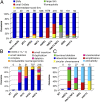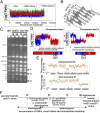Mutational landscape of yeast mutator strains
- PMID: 24449905
- PMCID: PMC3918763
- DOI: 10.1073/pnas.1314423111
Mutational landscape of yeast mutator strains
Abstract
The acquisition of mutations is relevant to every aspect of genetics, including cancer and evolution of species on Darwinian selection. Genome variations arise from rare stochastic imperfections of cellular metabolism and deficiencies in maintenance genes. Here, we established the genome-wide spectrum of mutations that accumulate in a WT and in nine Saccharomyces cerevisiae mutator strains deficient for distinct genome maintenance processes: pol32Δ and rad27Δ (replication), msh2Δ (mismatch repair), tsa1Δ (oxidative stress), mre11Δ (recombination), mec1Δ tel1Δ (DNA damage/S-phase checkpoints), pif1Δ (maintenance of mitochondrial genome and telomere length), cac1Δ cac3Δ (nucleosome deposition), and clb5Δ (cell cycle progression). This study reveals the diversity, complexity, and ultimate unique nature of each mutational spectrum, composed of punctual mutations, chromosomal structural variations, and/or aneuploidies. The mutations produced in clb5Δ/CCNB1, mec1Δ/ATR, tel1Δ/ATM, and rad27Δ/FEN1 strains extensively reshape the genome, following a trajectory dependent on previous events. It comprises the transmission of unstable genomes that lead to colony mosaicisms. This comprehensive analytical approach of mutator defects provides a model to understand how genome variations might accumulate during clonal evolution of somatic cell populations, including tumor cells.
Keywords: MUTome; genetic instability; genome drift; mutation accumulation lines; mutation profile.
Conflict of interest statement
The authors declare no conflict of interest.
Figures



Similar articles
-
Effects of Saccharomyces cerevisiae mec1, tel1, and mre11 mutations on spontaneous and methylmethane sulfonate-induced genome instability.Genes Genet Syst. 2010 Feb;85(1):1-8. doi: 10.1266/ggs.85.1. Genes Genet Syst. 2010. PMID: 20410660
-
Trajectory and uniqueness of mutational signatures in yeast mutators.Proc Natl Acad Sci U S A. 2020 Oct 6;117(40):24947-24956. doi: 10.1073/pnas.2011332117. Epub 2020 Sep 23. Proc Natl Acad Sci U S A. 2020. PMID: 32968016 Free PMC article.
-
Mutator genes for suppression of gross chromosomal rearrangements identified by a genome-wide screening in Saccharomyces cerevisiae.Proc Natl Acad Sci U S A. 2004 Jun 15;101(24):9039-44. doi: 10.1073/pnas.0403093101. Epub 2004 Jun 7. Proc Natl Acad Sci U S A. 2004. PMID: 15184655 Free PMC article.
-
Origin, Regulation, and Fitness Effect of Chromosomal Rearrangements in the Yeast Saccharomyces cerevisiae.Int J Mol Sci. 2021 Jan 14;22(2):786. doi: 10.3390/ijms22020786. Int J Mol Sci. 2021. PMID: 33466757 Free PMC article. Review.
-
Navigating yeast genome maintenance with functional genomics.Brief Funct Genomics. 2016 Mar;15(2):119-29. doi: 10.1093/bfgp/elv033. Epub 2015 Aug 31. Brief Funct Genomics. 2016. PMID: 26323482 Review.
Cited by
-
Mek1 Down Regulates Rad51 Activity during Yeast Meiosis by Phosphorylation of Hed1.PLoS Genet. 2016 Aug 2;12(8):e1006226. doi: 10.1371/journal.pgen.1006226. eCollection 2016 Aug. PLoS Genet. 2016. PMID: 27483004 Free PMC article.
-
Molecular signatures of aneuploidy-driven adaptive evolution.Nat Commun. 2020 Jan 30;11(1):588. doi: 10.1038/s41467-019-13669-2. Nat Commun. 2020. PMID: 32001709 Free PMC article.
-
A Noncanonical DNA Damage Checkpoint Response in a Major Fungal Pathogen.mBio. 2020 Dec 15;11(6):e03044-20. doi: 10.1128/mBio.03044-20. mBio. 2020. PMID: 33323516 Free PMC article.
-
Research highlights for issue 6: the applicability of model system research.Evol Appl. 2014 Jun;7(6):607-8. doi: 10.1111/eva.12182. Evol Appl. 2014. PMID: 25067945 Free PMC article. No abstract available.
-
Signification and Application of Mutator and Antimutator Phenotype-Induced Genetic Variations in Evolutionary Adaptation and Cancer Therapeutics.J Microbiol. 2023 Dec;61(12):1013-1024. doi: 10.1007/s12275-023-00091-z. Epub 2023 Dec 15. J Microbiol. 2023. PMID: 38100001 Review.
References
Publication types
MeSH terms
LinkOut - more resources
Full Text Sources
Other Literature Sources
Molecular Biology Databases
Research Materials
Miscellaneous

